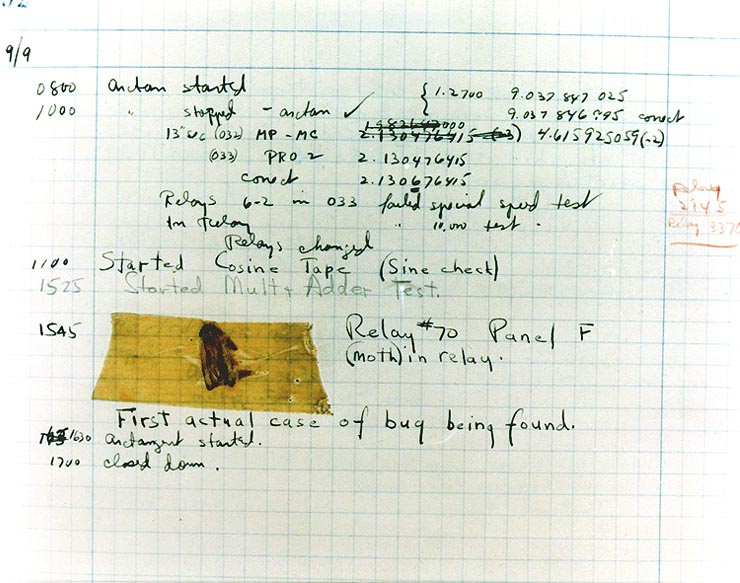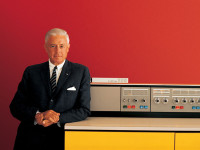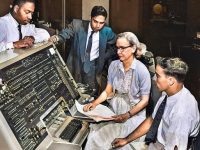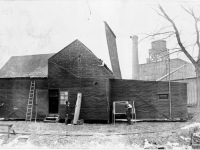
The first documented computer bug in a 1947 log file
© Naval Surface Warfare Center, Dahlgren, VA
Most of you might think that computers is one of these men’s business things. Far from it! Not even that it was a women who is often referenced as the first computer programmer in history – Ada Augusta King Countess of Lovelace [1] – it was also a woman in the early days of computers, who developed the very first compiler to translate high level language computer programs into low level machine commands. But besides her merits in computer science, we also owe the term ‘debugging‘ to Grace Hopper,[5] and the story goes like this….
1947 – The Harvard Mark II
It was on September 9 in 1947, when Grace Hopper was working on a Mark II Computer at Harvard University,[1] which was known for its high-speed electromagnetic relays. However, a moth was stuck in between the relays and after removing it, Hopper taped the moth into the log book, noting that the “First actual case of bug being found.” The story of Hopper’s ‘debugging‘ soon spread widely and caused that the term was from then on used for computer problems.
A Term with a longer History
However, the term ‘bugs‘ for causing mechanical or electronic issues has a longer history and is to be attributed to the famous inventor Thomas Edison.[3] In 1878, he wrote a letter to the inventor of the telephone exchange, Tivadar Puskás, mentioning ‘bugs‘ as being responsible for his technical difficulties:
“The first step [in all of my inventions] is an intuition, and comes with a burst, then difficulties arise – this thing gives out and [it is] then that ‘Bugs’ – as such little faults and difficulties are called – show themselves”
The Middle English word bugge is the basis for the terms “bugbear” and “bugaboo” as terms used for a monster.[4] Baffle Ball, the first mechanical pinball game, was advertised as being “free of bugs” in 1931. Problems with military gear during World War II were referred to as bugs (or glitches). Isaac Asimov [6] used the term “bug” to relate to issues with a robot in his short story “Catch That Rabbit“, published in 1944, and included in his well-known collection of short stories I, Robot. From page 1 of “Catch That Rabbit“: “U.S. Robots had to get the bugs out of the multiple robot, and there were plenty of bugs, and there are always at least half a dozen bugs left for the field-testing.” The related term “debug” also appears to predate its usage in computing: the Oxford English Dictionary’s etymology of the word contains an attestation from 1945, in the context of aircraft engines
Debugging
Even though Grace Hopper was not the ‘inventor’ of the term, she did a great job distributing it widely considering computer errors, but it must be said that this was not her only achievement during her long career as a computer scientist and US-Navy officer. This log book, complete with attached moth, is part of the collection of the Smithsonian National Museum of American History. Finding and fixing bugs, or debugging, is a major part of computer programming. Maurice Wilkes, an early computing pioneer, described his realization in the late 1940s that much of the rest of his life would be spent finding mistakes in his own programs. Possibly the most famous bug is the Year 2000 problem, also known as the Y2K bug, in which it was feared that worldwide economic collapse would happen at the start of the year 2000 as a result of computers thinking it was 1900. However, in the end, no major problems occurred.
Grace Hopper in a Nutshell
Grace Hopper has always been one of the curious kids, taking alarm clocks apart when she was seven and building toy vehicles she had designed by herself. After receiving her Ph.D from Yale University in 1934, she started teaching mathematics and joined the US-Navy at the age of 37. Soon she was assigned to a Computation Project at Harvard University as lieutenant, working on the Mark I computer, which was a special computer due to its Turing completeness (meaning that it was universally programmable). Some years later, she was developing the UNIVAC I and could make major contributions in designing the computer language COBOL, special due to its high dependence on the natural human language.
Grace Hopper depicts a pioneer in computer science and was honored numerous times, for instance she ironically won the ‘computer sciences man of the year’ award in 1969. She also received the National Medal of Technology in 1991.
Grace Hopper, Lecture at the University of Tennessee (1993) [7]
References and Further Reading:
- [1] Ada Lovelace – The World’s Very First Programmer, SciHi blog
- [2] Howard Aiken and the Harvard Mark I Computer, SciHi Blog
- [3] Mary Had a Little Lamb – Edison and the Phonograph in the SciHi blog
- [4] Grace Hopper at yale.edu
- [5] Grace Hopper and the Programing Languages, SciHi blog
- [6] Isaac Asimov and the Three Laws of Robotics, SciHi blog
- [7] Grace Hopper, Lecture at the University of Tennessee (1993), via Rick Graziani @ youtube
- [8] Computerworld staff (September 3, 2011). “Moth in the machine: Debugging the origins of ‘bug‘“. Computerworld.
- [9] Grace Hopper at Wikidata
- [10] Timeline for Grace Hopper. via Wikidata





